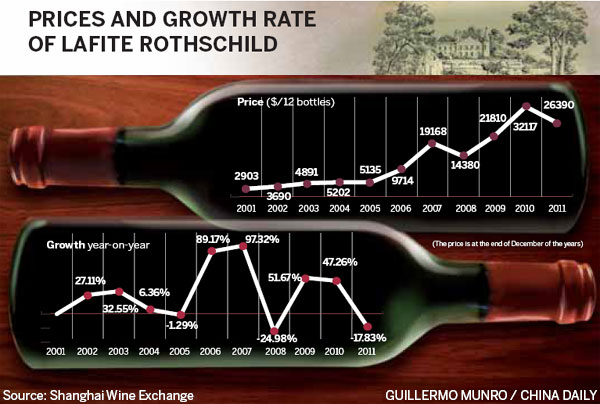Wine firm vows to protect Lafite's image
Updated: 2012-05-26 09:42
By Wang Zhuoqiong and Xiao Xiangyi (China Daily)
|
||||||||

The widespread presence of counterfeit Lafite wine in China has pressured its producer to launch a campaign to fight fake products in the country, after the price of Lafite wines tumbled last year.
Michel Negrier, export director of Domaines Barons de Rothschild Lafite, told China Daily on Friday that the group has hired legal professionals to fight counterfeit products.
An exclusive distributor, ASC Fine Wines, and the introduction of an authentication seal will also help Chinese consumers identify real Lafite wine.
Last year, the renowned winemaker exported 11 million bottles of Lafite wine, of which 1.5 million were destined for China, its biggest market in Asia.
Only 200,000 bottles of the group's iconic Chateau Lafite Rothschild wine, which is considered a high-end product among all Lafite varieties, are produced annually, but media reports claimed 600,000 bottles of the wine were traded in China last year.
"It is hard to calculate the numbers of counterfeit bottles of Lafite," Negrier said, on a trip to Beijing to launch the brand's official micro blog and attend a wine tasting event.
He said it is impossible to measure the extent of trading in fake Lafite wines from the numbers. The extra number of traded wines may have come from stock from previous years.
Foreign wine imports have significantly increased in China in recent years as consumer gradually shift from traditional Chinese liquor to wine.
Eyeing the growing market potential for red wine, in 2009, Domaines Barons de Rothschild Lafite opened a vineyard on the Penglai Peninsula in Shandong province in partnership with CITIC, a State-owned investment company.
Although the price of Lafite has fallen since late last year, it remains relatively high, said Wang Jiaqi, business development director of Shanghai Wine Exchange.
The exchange's 2012 Wine Investment Market Annual Report said the price of high-end fine wines experienced a long-term adjustment and decline last year. However, they will return to an upward trend this year, with an annual growth rate of more than 15 percent.
The price of Chateau Lafite Rothschild, which peaked between 2009 and 2010, declined significantly last year.
Lafite is the most traded red wine on the exchange, accounting for 20 to 30 percent, Wang said. Of traded Lafite wines, only 40 percent are for consumption.
"The price decline has squeezed bubbles and returned the market to a more rational situation," she said. "But Lafite is still one of the most powerful brands of foreign wine, and the first brand most Chinese consumers think about."
Demand for high-end wine at business banquets is so strong that its price will remain high, she said.
Wang said that a good way to protect the brand is to ensure Chinese consumers know more about wine.
Lin Libo, executive publisher and managing director of La Revue du Vin de France, a Chinese edition of a French wine magazine, agreed about the importance of the promotion of wine culture in the country.
"China has fake Moutai, a renowned liquor. But many consumers have learned how to tell the difference over the years. The more consumers know, the less chance they will be tricked by counterfeit wine," she said.
Contact the writers at wangzhuoqiong@chinadaily.com.cn and xiaoxiangyi@chinadaily.com.cn

 Relief reaches isolated village
Relief reaches isolated village
 Rainfall poses new threats to quake-hit region
Rainfall poses new threats to quake-hit region
 Funerals begin for Boston bombing victims
Funerals begin for Boston bombing victims
 Quake takeaway from China's Air Force
Quake takeaway from China's Air Force
 Obama celebrates young inventors at science fair
Obama celebrates young inventors at science fair
 Earth Day marked around the world
Earth Day marked around the world
 Volunteer team helping students find sense of normalcy
Volunteer team helping students find sense of normalcy
 Ethnic groups quick to join rescue efforts
Ethnic groups quick to join rescue efforts
Most Viewed
Editor's Picks

|

|

|

|

|

|
Today's Top News
Health new priority for quake zone
Xi meets US top military officer
Japan's boats driven out of Diaoyu
China mulls online shopping legislation
Bird flu death toll rises to 22
Putin appoints new ambassador to China
Japanese ships blocked from Diaoyu Islands
Inspired by Guan, more Chinese pick up golf
US Weekly

|

|







